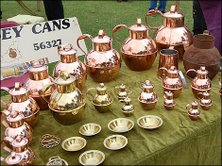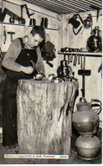It is the last surviving relic of Guernsey’s Norman ancestry, with a pedigree of nearly one thousand years. It’s the pride of every true Guernsey home, be it a granite cottage, a farmhouse, or the fancy manor of a feudal fief. Oh yes, it’s the Guernsey Can.
Its function is now purely decorative, but it was used in industry as late as the beginning of the 20th Century. The design of the can has changed very little over the years. The functionality and ergonomics of the original can cannot be disputed. The traditional Guernsey Field Can was made from tin plate steel and was soldered on the outside. It was constructed from 10 or 11 individual pieces, depending on which one of the 17 different sizes was being made. The neck of the Guernsey Field Can has a proportionally larger circumference compared to the smaller sized table cans. The larger opening makes for a bigger target during milking, and means the neck is lower down the spherical body of the can, resulting in a lower more stable centre of gravity. The can is made steadier by three domed feet, which offer maximum stability on a grassy surface. The spherical shape of the can offers a handy fit between the maid’s legs during milking, whilst minimising the amount of milk slopping out of the top. The narrow opening means that the can has an advantage over a bucket as it is less prone to being tipped by stray cows’ feet.
These design features mean that, ergonomically, the Guernsey Can is incredibly strong. Rather like an egg, it can carry the maximum amount of liquid possible using the minimum of materials. The modern half pint can is constructed from just one 8.5 inch square of half millimeter copper. Although the can does not have a spout, its ingenious design means it will pour with the precision of a jug, and yet can be hermetically sealed.
The transition from the practical Guernsey Can to a decorative feature is a point of debate. Some believe that the combination of the introduction of new materials such as plastic together with the influx of tourism during the 1950’s played a big part in the shift. Some of the oldies out there might even remember that Guernsey was also keen to embrace the introduction of the Tetra Pak closely followed by the stylish milk bag.
All in all, the Guernsey Can is an amazing legacy of Guernsey tradition, combining efficiency with aesthetics. Yet surprisingly few Guerns are aware of the cans and their rich history. Well, consider yourself informed!
You can learn more about Guernsey Cans at www.guernseycans.co.uk
Rostone
XEROX Issue 3



Ah, how could we forget the Guernsey Can’s cameo in Guernsey’s most famous piece of contemporary literature – The Book of Ebenezer Le Page. Denied Liza Queripel hand in marriage, the Guernsey ‘everyman’ and anti-hero to Hugo’s Gilliat, Ebenezer buys Liza a Guernsey Can which she promises never to sell, not even when hungry. Despite all her wrongs, her collaboration with the Germans during the Occupation and condemnation of Ebenezer to a life of loneliness, the can still has pride of place on her mantelpiece when the two reconcile in the final chapter of the book.